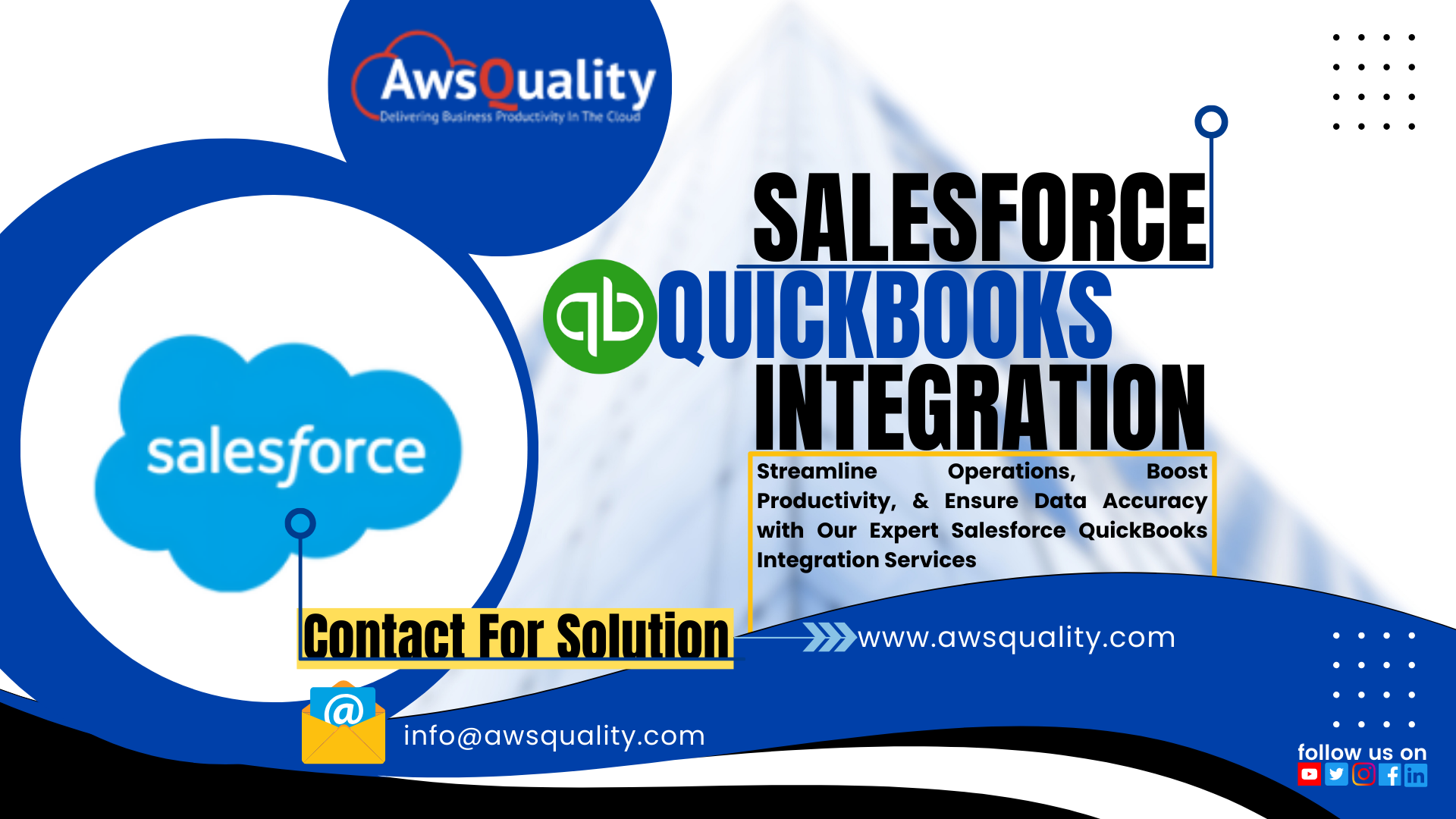
Streamline Operations, Boost Productivity, and Ensure Data Accuracy with Our Expert Salesforce QuickBooks Integration Services
Starting in the global business world of 2024, enhance your e-learning business’s productivity with seamless integration between Salesforce CRM Cloud and QuickBooks. Our Salesforce consulting services ensure secure, real-time synchronization, streamlining vendor management, invoice processing, and data accuracy. Benefit from efficient workflows and robust security protocols tailored to your organization’s needs. Integrate QuickBooks with Salesforce CRM Cloud to optimize operations, boost efficiency, and drive growth in the rapidly evolving digital landscape.
Integrating Salesforce QuickBooks for a Massive E-Learning Platform.
Let’s examine the advantages this Salesforce QuickBooks Integration may provide for a company like that:
-
Background of the client:
- The client is an online learning business with headquarters in Texas that provides seminars, conferences, training programs, and classes to boost output.
- They asked for help connecting Salesforce and QuickBooks.
-
The Obstacle:
- Integrating QuickBooks Desktop with Salesforce Cloud CRM was the main obstacle.
- Efficient data synchronization between these two systems was the aim.
-
Resolution:
- Avankia’s DBSync was utilized by the integration to overcome this obstacle.
- This is how it was put into practice:
- DBSync Setup: Field mapping and scheduling were done as part of the comprehensive DBSync setup.
- Real-Time Sync: To allow real-time synchronization between QuickBooks (Desktop) and Salesforce, buttons were built.
- Customization: A number of custom fields, triggers, apex batch classes, and custom objects were made in QuickBooks.
-
Successes:
- The following advantages of the integration were realized:
- End-to-end management of vendors and invoices: Skillful processing of vendor-related information and bills.
- Bi-Directional Invoice Sync: Guaranteed data consistency between QuickBooks and Salesforce.
- Offline Invoice Management: Made it possible to handle smoothly even while not online.
- Extremely Secure: Throughout the procedure, data security and integrity were upheld.
Consult with specialists if you’d like additional information or need help with a similar integration.
How does the sync in real time operate?
To keep accurate and current data, Salesforce and QuickBooks must be synchronized in real-time. Let’s examine its operation:
-
Instruments for Integration:
- Real-time syncing between several platforms is made possible by a number of integration technologies. Among the well-known ones are:
- DBSync: A powerful platform for integration that links QuickBooks and Salesforce. By enabling two-way data transmission, it guarantees consistency.
- SyncQ: A program made especially to integrate QuickBooks with Salesforce, allowing for smooth data transfer.
2. 2-Way Real-Time Sync:
- The integration tool recognizes changes made to records in Salesforce as they are created or changed.
- After that, the tool sets off an event to synchronize the relevant data with QuickBooks.
- In a similar vein, Salesforce automatically updates with modifications made in QuickBooks.
-
Sync Through a Button:
- Users can manually start a sync in Salesforce by clicking a specific button (such as the “SyncQ Button”).
- The two systems now share data in real time as a result of this.
-
Auto-synchronization
- Users have the option to enable auto-sync for even more efficiency.
- When auto-sync is enabled, records synchronize automatically—manually—without interaction.
- For instance, a related customer is added in QuickBooks when an account is established in Salesforce.
-
Mapping Data:
- Data fields are mapped from Salesforce to QuickBooks during setup.
- This guarantees the proper transmission of pertinent data, including contacts, invoices, and goods.
-
Advantages:
- Efficiency: reducing time and effort by avoiding redundant data input.
- insights: Offers a comprehensive perspective on financial facts to improve forecasts.
- Accuracy: Ensures trustworthy and consistent data on both platforms.
Keep in mind that real-time synchronization promotes teamwork, lowers mistakes, and gives your e-learning business the ability to run smoothly!
To what extent is this integration secure?
One important factor to take into account when connecting Salesforce with QuickBooks is security. Now let’s explore the security features:
-
Data Protection and Privacy:
- Data security is given top priority by QuickBooks and Salesforce.
- QuickBooks is reliant on sophisticated, widely accepted security measures, including as firewall-protected servers, password-protected sign-ins, and encryption technologies utilized by leading banks1.
- Salesforce has strong security protocols to safeguard confidential data.
-
Verification and Permission:
- Make sure robust authentication measures are in place during integration setup.
- To ensure safe communication between systems, use API keys or OAuth tokens.
- Restrict access to authorized users only.
-
The encryption process
- When sending data between QuickBooks and Salesforce, HTTPS (SSL/TLS) should be used for encryption.
- Sensitive information is protected in transit thanks to encryption.
-
Audit Trails:
- Keep thorough records of all integration-related activities.
- Keep an eye on user interactions, sync events, and modifications.
- Audit trails are useful for discovering irregularities or illegal access.
-
Control Over User Access:
- Limit who may view the integration settings.
- Give responsibilities and rights with caution.
- Adhere to the least privilege principle.
-
Notifications and Error Handling:
- Put in place reliable error-handling procedures.
- Report any integration issues to the admins right away.
- It is possible to stop data exposure quickly.
-
Frequent Evaluations of Security:
- Evaluate security on a regular basis.
- Check to see if security measures are working.
- Quickly address any weaknesses.
-
External Resources:
- Make sure the third-party connections (such as SyncQ and DBSync) have secure procedures before utilizing them.
- Select trustworthy instruments with a history of adhering to security regulations.
Secure and effective data transmission between Salesforce and QuickBooks is ensured by a well-implemented integration and adherence to security best practices. Consult with specialists to customize security measures to your organization’s needs if you have specific issues or want further help.
In conclusion,
Experience seamless integration of QuickBooks with Salesforce CRM Cloud at AwsQuality Technologies. Our expertise ensures real-time synchronization, boosting productivity and data accuracy for your e-learning business. Trust us to tailor a secure solution that streamlines operations and maximizes efficiency.




